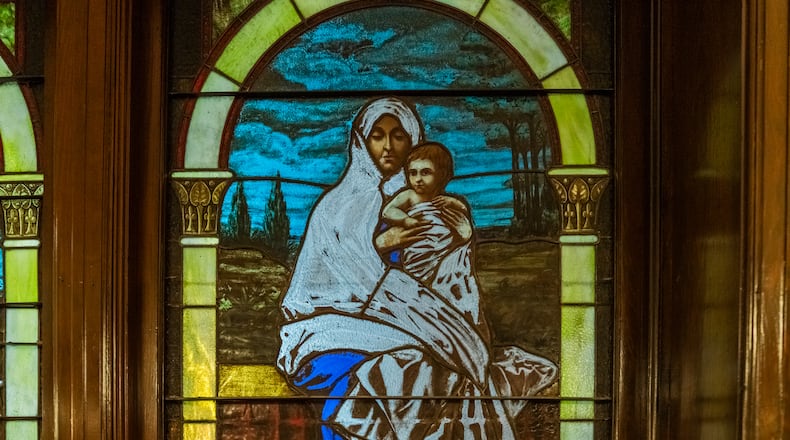Over a video chat, David Levering Lewis is sharing the story about how he found the muse for his latest book inside one of Atlanta’s oldest churches.
Nearly 10 years ago, the New York University professor, historian and Pulitzer Prize winner was sitting in historic First Congregational Church, admiring a triptych of stained glass windows installed to honor families crucial to its construction.
One pane in particular stood out.
A luminous image depicting the Madonna and child against a backdrop of dark blue skies. Partially missing at the bottom was a memorial dedication to Lewis’ maternal grandmother, Alice King Bell. The matriarch’s image on the pane was created with Bell’s likeness.
That’s when it dawned on him.
“I thought that I didn’t know really a great deal about my past. I didn’t know much about her. But I had, of course, heard the echoes of what she was supposed to mean,” Lewis told The Atlanta Journal-Constitution.
Credit: Frank L. Stewart
Credit: Frank L. Stewart
Lewis’ latest book, “The Stained Glass Window: A Family History as the American Story, 1790-1958,” released on Feb. 11, took the scholar outside of his comfort zone, digging into the turning points, tragedies and triumphs befalling Black families such as his.
Whereas his first 11 books chronicled the lives of others, “The Stained Glass Window” is Lewis’ most personal work. It’s also the topic of his Feb. 20 author talk with Georgia Public Broadcasting’s Peter Biello at the Atlanta History Center.
By exploring more about the woman in the window, Lewis was simultaneously shocked, hurt, and proud of what pre- and post-Civil War America revealed about his family and himself.
“I thought, well, let me understand how my own life can be representative of so much of our collective history,” he said.
When it comes to helping Americans understand the past, there are few greater than Lewis. Two of his biographies on W.E.B. Du Bois won Pulitzers. He’s one of the earliest biographers of the Rev. Martin Luther King Jr. and documenters of the Harlem Renaissance.
With “The Stained Glass Window,” Lewis’ journey covers three centuries sprouting from his family tree with stops that include Roswell, Liberty County, Americus, Atlanta and parts of South Carolina.
That story revolves around four families.
There was the white, slaveholding Kings of Roswell and Belvins of Houston County. The South Carolina Bells, free people of color that owned slaves, who ended up on Auburn Avenue. Rounding out the familial quartet were the Lewises, a family navigating life in post-Emancipation Proclamation Georgia.
At the onset, Lewis thought his latest project — originally written in the third person — would be “a family book about some interesting people.” That modest mission took a major turn as Lewis perused census, tax and insurance data that led him to Alice Bell’s mother, Clarissa King, whom was said to have had origins in Roswell.
After connecting with an archivist, Lewis learned Clarissa King was an enslaved woman born in Liberty County who followed her master, James Belvin, to Roswell. In a revelation that floored him, Lewis confirmed his genetic link to James Belvin with an assist from a professional genealogist.
Credit: The Atlanta Journal-Constitution
Credit: The Atlanta Journal-Constitution
James Belvin fathered five children with Clarissa King, his wife’s maid. “Her complicated lineage aroused my deepest professional and personal fascination,” Lewis writes in Chapter 2, “Clarissa’s Bargain.”
The aforementioned bargain alludes to the miscegenation between slaves and their masters in the Antebellum South. The relationship between James Belvin and Clarissa King resulted in the freed slaves living on Wheat Street (now Auburn Avenue) in Atlanta when he passed.
“My great-grandfather, the slave master, was a curiously positive force,” Lewis said. “That is to say he did not buy slaves. He did not sell slaves. He opposed secession. And at the end of the day, he was outwitted by the woman in his life.”
“There are layers of history here that I’ve got to excavate and so I did,” he said.
Through slavery, the Civil War, Reconstruction and the Civil Rights Movement, Lewis dedicates considerable focus to the experiences of his family members, their stories of survival.
A major character of Lewis’ story is Atlanta. It’s the city where his family’s church was built. The stained glass window got there by way of dedication from his maternal grandfather after the 1906 Atlanta Race Massacre.
Credit: Ronald Williams/AJC
Credit: Ronald Williams/AJC
Lewis’ father, John Henry Lewis, served as president of Morris Brown from 1920-1928 and 1951-1958.
An admirer of Du Bois and Thurgood Marshall, John Henry Lewis was a champion for Black education in the South, leading schools in Arkansas and Ohio before moving the family to Atlanta for his second successful stint at Morris Brown. To this day, the John Henry Lewis gymnasium still stands as a monument to its namesake.
Lewis' mother, Alice Urenstine Bell, was inspired by activists such as Carrie Steele. She was part of the NAACP’s new Women’s Registration Committee, which helped secure victory in a 1921 bond election vote that led to the construction of four new Black elementary schools and Booker T. Washington High School.
The latter was Atlanta’s first high school for Black youth. It’s also where Alice Urenstine Bell became a teacher of mathematics. She also directed school plays, mentoring a young Eva Rutland and Lena Horne.
When historically Black colleges and universities struggled with enrollment during the Great Depression, she graduated with a Bachelor of Arts as a Morehouse woman in 1929. (Yes, that was a thing.)
It’s in Atlanta where Lewis explores where stories of Black progress clashed with racism, classism and violence that came with the city’s power structure pre-1960s.
The most telling example Lewis finds of this is in the 1948 death of his cousin who was severely beaten by police in Atlanta for allegedly stealing cigarettes from a country club. Reports in The Atlanta Daily World, at the time the country’s only Black daily, said Lewis’ cousin died from blunt force head trauma as a result of police brutality.
Despite then-Atlanta Mayor William Hartsfield moving to integrate the police force for the first time in 1948, Lewis was incredibly distressed by finding this information. Specifically, he found himself angry with relatives whom he didn’t feel raised enough hell at the risk of losing their standing among the hierarchy of Black folks in Atlanta.
“No thanks to John Levering Bell Sr., his son’s death may still have been useful to campaign of Black police officers,” he writes in the book’s final chapter, “With All Deliberate Speed.”
It’s a fact that Lewis had to begrudgingly accept. “You have to keep an objective ambition and a personal one separate,” he said.
Loss is prevalent throughout Lewis’ story.
He talked about the last conversation he had with his father, a moment addressed in “The Stained Glass Window.” Lewis hopes his work as a historian is a legacy that would make mom and dad proud.
“I hope in a small way that the books I’ve written are useful,” he said.
With “The Stained Glass Window,” Lewis' investigative expedition into his family history and their influence on Atlanta is more than useful, it’s necessary.
EVENT PREVIEW
David Levering Lewis Author Talk
Thursday, Feb. 20. 7 p.m. $6-$12 (free for Insiders). McElreath Hall, Atlanta History Center. 404-814-4081. atlantahistorycenter.com.
ABOUT THIS SERIES
This year’s AJC Black History Month series, marking its 10th year, focuses on the role African Americans played in building Atlanta and the overwhelming influence that has had on American culture. These daily offerings appear throughout February in the paper and on AJC.com and AJC.com/news/atlanta-black-history.
About the Author
Keep Reading
The Latest
Featured







